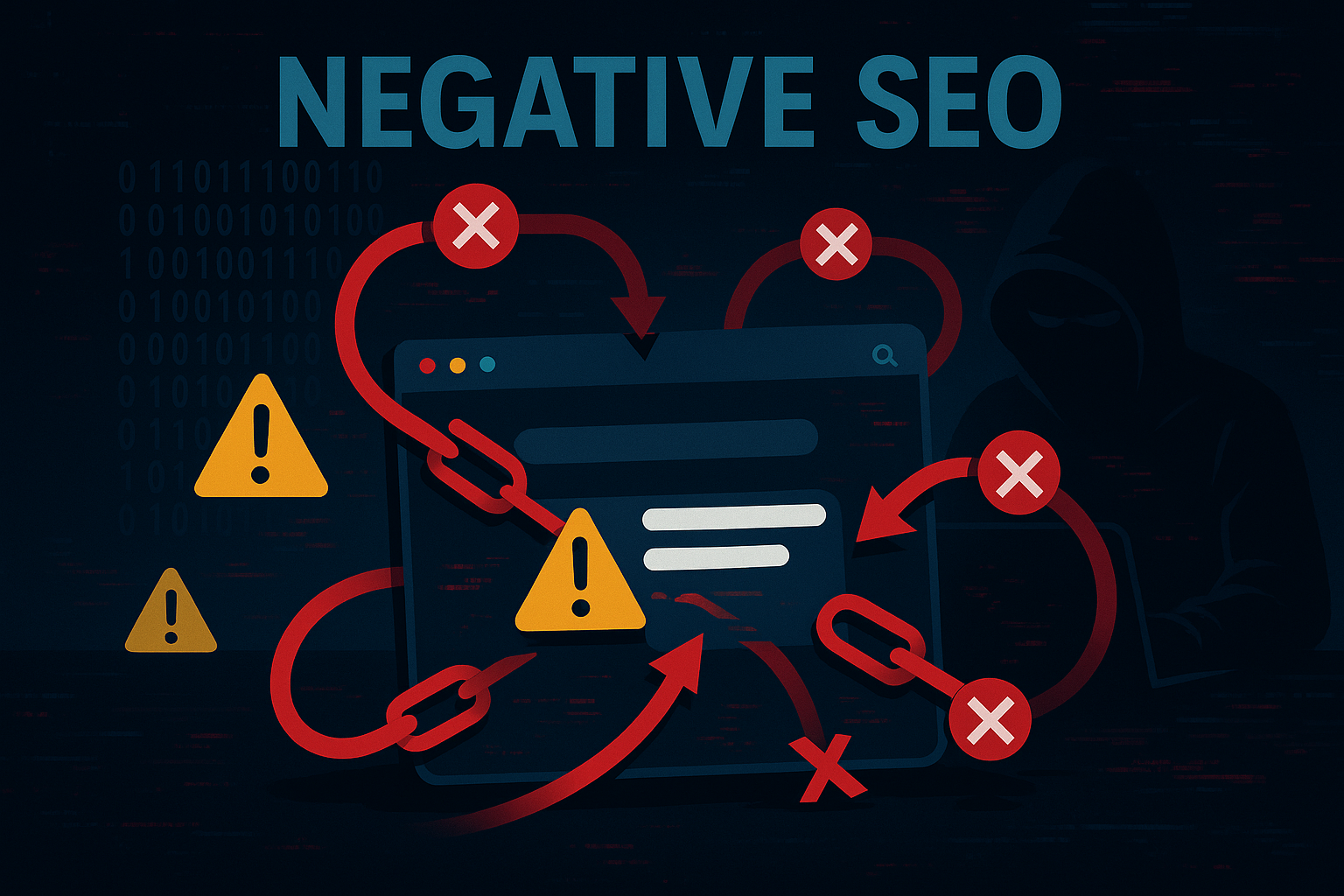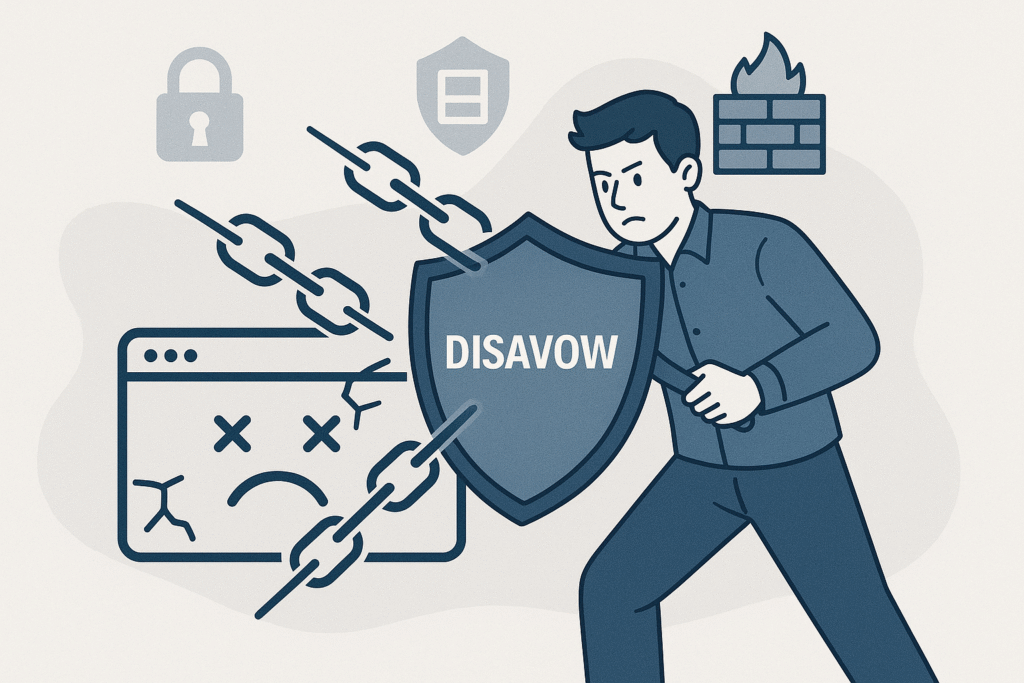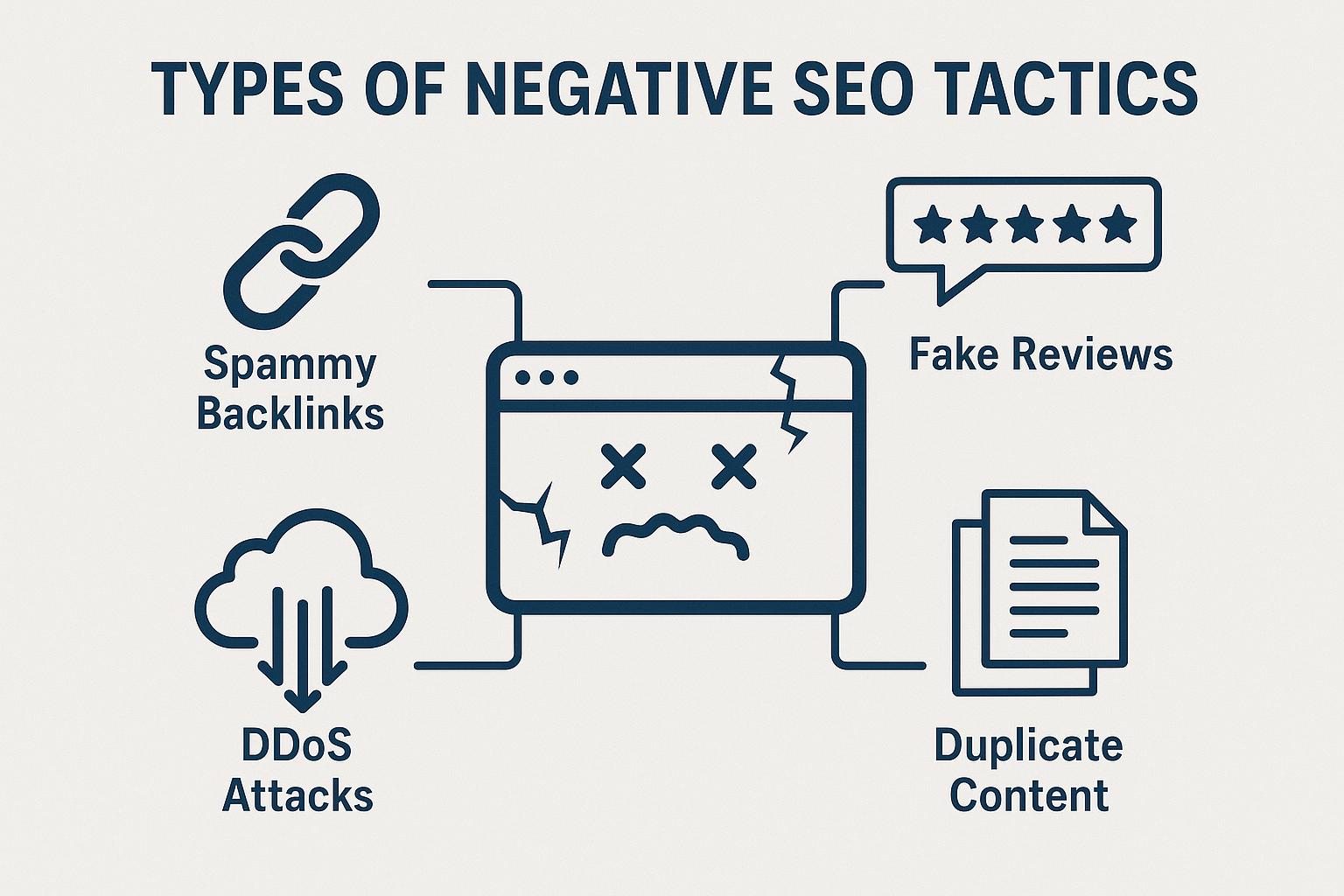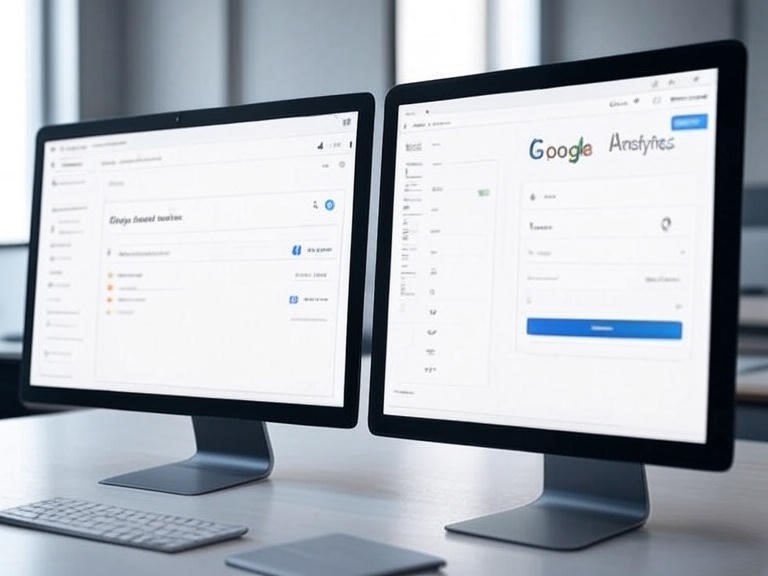
In today’s hyper-competitive digital world, SEO (Search Engine Optimization) is essential for driving traffic and improving visibility. But while most businesses focus on positive SEO strategies, there’s a dark side too — Negative SEO.
This blog will guide you through everything you need to know about negative SEO, including what it is, how it works, how to identify it, and how to protect your website from it.
Table of Contents
In the competitive world of digital marketing, search engine optimization (SEO) is a cornerstone for driving traffic and boosting online visibility. However, not all SEO practices are ethical or constructive. Negative SEO tactics, designed to harm a competitor’s website rankings rather than improve one’s own, have emerged as a dark side of the SEO landscape. This blog post explores what negative SEO is, common tactics used, and actionable steps to safeguard your website.
Negative SEO Meaning: What is Negative SEO?
Negative SEO attacks can take many forms, including:
- Toxic Backlinks: Massively building low-quality or spammy links to your site.
- Content Scraping & Duplication: Copying your content and spreading it across multiple sites to trigger duplicate content penalties.
- Fake Reviews & Social Signals: Creating fake negative reviews or engagement to damage reputation.
- Hacking & Malware Injection: Gaining unauthorized access to inject malicious code or redirects.
- Click Fraud: Using bots to generate fake clicks on paid ads, increasing costs.
Negative SEO Services: A Dangerous Market
Some unethical agencies or freelancers (even on platforms like Fiverr) offer "Negative SEO services", claiming they can destroy competitors' rankings. However, Google’s algorithms have improved, making most of these tactics ineffective. Moreover, engaging in such practices violates Google’s guidelines and can lead to legal consequences.
Negative SEO Backlinks: The Most Common Threat
A sudden influx of spammy backlinks from irrelevant or penalized sites can hurt rankings. Google’s Disavow Tool helps remove such links, but monitoring backlink profiles regularly is crucial.
Buy Negative SEO? Think Twice.
If you're thinking of buying negative SEO services to harm a competitor — don’t. It’s unethical, it can backfire, and you could be reported or sued.
Focus on improving your own SEO rather than trying to destroy someone else's.
How to Report Negative SEO to Google
If you suspect an attack, take these steps:
- Audit Your Backlinks (using Google Search Console, Ahrefs, or SEMrush).
- Disavow Toxic Links via Google’s Disavow Tool.
- Report Spam or Malicious Activity through Google’s Spam Report Form.
- Monitor Rankings & Traffic for unusual drops.
How to Protect Your Website from Negative SEO

1. Monitor Your Backlink Profile Regularly
Use tools like Ahrefs, SEMrush, or Google Search Console to track new backlinks to your site. If you notice a sudden influx of low-quality or suspicious links, disavow them using Google’s Disavow Tool. Regularly auditing your backlink profile helps you catch and address issues early.
2. Enable Google Alerts for Your Brand
Set up Google Alerts to monitor mentions of your brand or website online. This can help you detect content scraping, unauthorized republishing, or negative campaigns targeting your business.
3. Secure Your Website
Protect your site from hacking by implementing strong security measures. Use HTTPS, keep software and plugins updated, enable two-factor authentication, and invest in a robust web application firewall (WAF). Regular security audits can help identify vulnerabilities before they’re exploited.
4. Track Rankings and Traffic
Monitor your site’s search rankings and organic traffic using tools like Google Analytics or Moz. Sudden, unexplained drops in rankings or traffic could indicate negative SEO. Early detection allows you to investigate and take corrective action.
5. Claim and Manage Online Profiles
Claim your business listings on platforms like Google My Business, Yelp, and other review sites. Actively monitor and respond to reviews to mitigate the impact of fake negative feedback. Encourage genuine customer reviews to dilute malicious ones.
6. Use Canonical Tags for Content
To combat content scraping, implement canonical tags on your web pages. These tags signal to search engines which version of your content is the original, reducing the risk of duplicate content penalties.
7. Protect Against DDoS Attacks
Partner with a reliable hosting provider that offers DDoS protection. Services like Cloudflare can help mitigate traffic surges and keep your site accessible during an attack.
8. Document Everything
Keep detailed records of your SEO performance, backlink profile, and any suspicious activity. If you suspect negative SEO, this documentation can help you make a case to search engines for reconsideration if penalties are applied.
you can use tools like Google’s free SEO tools to monitor changes in backlinks and site performance.
What to Do if You’re Targeted
If you believe your website has been hit by negative SEO, act quickly:
- Identify the Issue: Use analytics and SEO tools to pinpoint the source of the problem, such as toxic backlinks or duplicate content.
- Take Corrective Action: Disavow bad links, report fake reviews, or restore hacked content from backups.
- Contact Search Engines: If your site is penalized, submit a reconsideration request to Google with evidence of the attack and steps you’ve taken to resolve it.
- Consult an SEO Expert: For complex cases, professional SEO services can help diagnose and recover from negative SEO attacks.
Does Malicious SEO Work Without Backlinks? Yes, It’s Possible
Malicious SEO tactics can harm a website’s rankings without relying on backlinks. Attackers often exploit vulnerabilities in search engine algorithms or user trust through deceptive methods. Below, we explore several non-backlink strategies that can disrupt a site’s performance and reputation.
1. Content Scraping & Duplication
Perpetrators may steal a website’s content—such as blog posts, product descriptions, or entire pages—and republish it on low-quality or spammy websites. This creates duplicate content across the web, which can confuse search engines about the original source. For example, a competitor might scrape your carefully crafted articles and post them on dozens of obscure blogs, diluting your site’s authority. Search engines may struggle to identify the legitimate source, potentially lowering your rankings or flagging your site for plagiarism. In extreme cases, attackers may even submit your content to directories or aggregators to amplify the duplication effect, further muddying the waters.
2. Fake Negative Reviews
Another tactic involves flooding review platforms like Google My Business, Yelp, or Trustpilot with fake negative reviews. These reviews, often posted by bots or hired individuals, aim to tarnish a business’s reputation and erode consumer trust. For instance, a sudden influx of one-star reviews claiming poor service can harm a local business’s visibility in local search results, as search engines factor in review sentiment and volume. This approach can also deter potential customers, directly impacting revenue. Attackers may craft reviews to appear credible, using realistic names or vague complaints, making it harder for platforms to detect and remove them.
3. Bot Traffic to Trigger Penalties
Malicious actors may deploy bots to flood a website with artificial traffic, creating the illusion of suspicious activity. For example, bots can generate excessive page views, high bounce rates, or unnatural user behavior patterns, such as rapid clicks from a single IP address. Search engines might misinterpret this as an attempt to manipulate analytics or user engagement metrics, potentially leading to penalties. Additionally, overwhelming a site with bot traffic can strain server resources, slow down performance, and negatively affect user experience, which indirectly impacts SEO rankings.
4. Social Media Impersonation
Attackers may create fake social media profiles mimicking a brand or website to spread misinformation or damage its reputation. These impostor accounts might post offensive content, engage in spammy behavior, or mislead followers, causing confusion and distrust. For example, a fake Twitter or Instagram account posing as your business could share links to malicious sites or post inflammatory comments, prompting users to report the account. While this may not directly affect search rankings, it can harm brand credibility, reduce user engagement, and weaken the signals search engines use to assess a site’s authority.
These tactics demonstrate that harmful SEO strategies extend beyond backlinks, targeting a website’s content, reputation, and technical performance. By understanding these threats, website owners can take proactive steps—such as monitoring content duplication, managing
Negative SEO on Fiverr: Beware of the Gig Economy Threat
Many black-hat negative SEO Fiverr gigs offer cheap and quick ways to harm competitors. These services often use automated tools to generate spam backlinks or submit fake reports.
However, Google has become much smarter. In many cases today, negative SEO does not work as it once did — Google’s algorithm can now detect and ignore many spammy practices. But that doesn’t mean you're 100% safe, especially if you don’t monitor your site regularly.
Effects of Negative SEO on Rankings
If successful, Negative SEO can lead to:
- Sudden ranking drops
- Manual penalties from Google
- Loss of organic traffic
- Reputation damage
Common Negative SEO Tactics to Watch For

Some of the most frequently used negative SEO techniques include:
- Spammy Backlink Bombing: Creating thousands of low-quality or toxic backlinks to your website.
- Scraping and Duplicating Content: Copying your content and publishing it across the web.
- Fake Reviews or Reports: Posting fake negative reviews on business directories or review platforms.
- Hacking the Website: Altering code, inserting malicious scripts, or de-indexing important pages.
- Forced Crawling or Server Overload: Using bots to crash your site or slow down page speed.
- Disavow Bombing: Submitting your genuine backlinks to Google’s disavow tool to remove their value.
🕵️♂️ How to Track and Identify Negative SEO Attacks
Recognizing a negative SEO attack early is crucial to minimize damage. Fortunately, with the right tools and vigilance, you can detect suspicious activities before they seriously affect your rankings.
🔍 1. Monitor Your Backlink Profile
A sudden surge in low-quality or irrelevant backlinks can be a red flag. Use tools like:
- Google Search Console
- Ahrefs
- Semrush
These tools help you spot spammy backlinks and allow you to take timely action.
- ✅ Related: Learn about Google’s free SEO tools that help monitor your site’s health.
📉 2. Watch for Unusual Ranking Drops
A negative SEO attack often causes a sharp drop in rankings or traffic for no obvious reason. You can identify this using tools like:
- Google Analytics
- Google Search Console
💡 Want to know which tool gives better insights? Check out our comparison of Google Search Console vs Google Analytics.
✍️ 3. Look for Duplicate Content
Use tools like Copyscape or Siteliner to see if someone has copied your content across other websites. Content scraping is a common negative SEO tactic meant to cause duplicate content penalties.
🔄 4. Keep an Eye on Page Speed and Uptime
If bots are overloading your server (DDoS-style attack), your website may become slow or temporarily unavailable — a silent SEO killer. Use monitoring tools like:
- UptimeRobot
- Pingdom
- Jetpack (for WordPress users)
🧩 5. Check for Indexing Issues
Sometimes, attackers may de-index your important pages. Regularly inspect your site’s index status via Google Search Console to ensure everything is intact.
🔔 Pro Tip:
Set up Google Alerts for your brand name or unique content phrases. This can help you detect fake mentions, spam content, or stolen articles quickly.
Does Negative SEO Really Work?
Google’s algorithms have evolved to detect unnatural patterns, making most Negative SEO attacks ineffective. However, vigilance is key—ignoring threats can still lead to temporary ranking losses.
What to Do if You’re Targeted
If you believe your website has been hit by negative SEO, act quickly:
- Identify the Issue: Use analytics and SEO tools to pinpoint the source of the problem, such as toxic backlinks or duplicate content.
- Take Corrective Action: Disavow bad links, report fake reviews, or restore hacked content from backups.
- Contact Search Engines: If your site is penalized, submit a reconsideration request to Google with evidence of the attack and steps you’ve taken to resolve it.
- Consult an SEO Expert: For complex cases, professional SEO services can help diagnose and recover from negative SEO attacks.
Final Thoughts: Stay Protected
Negative SEO is an unethical practice that exploits the competitive nature of online marketing. While it can pose serious risks, staying vigilant and proactive can protect your website from harm. Regularly monitor your site’s performance, secure its infrastructure, and stay informed about evolving SEO threats. By building a strong, ethical SEO foundation, you can not only defend against negative tactics but also strengthen your site’s long-term ranking potential.
Stay ahead of the game, keep your digital assets secure, and focus on delivering value to your audience—because the best defense against negative SEO is a robust, authentic online presence.
Negative SEO is a real but often exaggerated threat. By proactively monitoring your site, disavowing toxic links, and securing your online presence, you can minimize risks. Focus on building a strong, ethical SEO strategy rather than worrying about sabotage.
By staying informed and taking preventive measures, you can keep your website safe from malicious competitors.
FAQs on Negative SEO
Q1: Can negative SEO affect my Google rankings?
Yes, if not detected early, negative SEO can drop your rankings and traffic.
Q2: How do I disavow bad backlinks?
Use Google’s Disavow Tool by uploading a .txt file containing the bad URLs or domains.
Q3: Is negative SEO legal?
No, many negative SEO tactics violate Google’s guidelines and can also be legally questionable.
Q4: Can I protect my new website from negative SEO?
Yes, set up alerts, secure your site, and monitor backlinks regularly.
Q5: What if Google ignores the spam links?
Google may ignore some low-quality links, but not always. That’s why manual disavow is important.
Q6. How often should I check for Negative SEO threats?
Perform a monthly backlink audit and monitor rankings weekly using tools like Ahrefs, SEMrush, or Google Search Console.
Q7. How can I detect a Negative SEO attack?
Look for:
Sudden drops in rankings
Unnatural spikes in backlinks
Duplicate content appearing elsewhere
Fake negative reviews or social media mentions
Q8. Can Negative SEO destroy my rankings permanently?
Google’s algorithms are designed to detect and ignore most manipulative tactics. However, severe attacks can cause temporary ranking drops if not addressed.
What is your product?
How can I purchase it?
Is there a warranty?
Key Takeaways
✅ Negative SEO involves malicious tactics (spam links, fake reviews, hacking) to sabotage competitors’ rankings.
✅ Google’s algorithms are resilient, but severe attacks can still cause temporary ranking drops.
✅ Protect your site by auditing backlinks, disavowing toxic links, securing your website, and monitoring brand mentions.
✅ Never engage in Negative SEO services—they’re unethical, often ineffective, and can backfire legally.
✅ Report suspicious activity to Google via the Spam Report Form and use the Disavow Tool for harmful backlinks.
✅ Prevention is key—strong security, regular monitoring, and ethical SEO practices minimize risks.
Disclaimer
The information provided in this blog post is for educational purposes only. Negative SEO is an unethical practice, and we do not endorse or encourage its use.
- Google’s algorithms constantly evolve, and while Negative SEO attacks may sometimes impact rankings, most are ineffective long-term.
- Engaging in Negative SEO services (buying or selling) violates search engine guidelines and may lead to penalties.
- Always follow white-hat SEO strategies to maintain a sustainable and penalty-free online presence.
For legal and professional SEO advice, consult a certified digital marketing expert.



